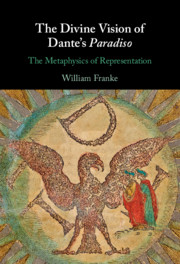Book contents
- The Divine Vision of Dante’s Paradiso
- The Divine Vision of Dante’s Paradiso
- Copyright page
- Contents
- Figures
- Prologue
- Acknowledgments
- Note on Translations and Primary Source Editions
- Part I The Literary Vision
- Chapter 1 Writing as Theophany: The Medium as Metaphor for Immediacy
- Chapter 2 The Presence of Speech in Writing: Speaking as Sparking
- Chapter 3 The Parts of Speech: Mediation and Contingency
- Chapter 4 From Speculative Grammar to Visual Spectacle and Beyond
- Chapter 5 Sense Made Sensuous and Synaesthesia in the Sight and Sound of Writing
- Chapter 6 Infinite Script: Endless Mediation as Metaphor for Divinity
- Part II Philosophical Reflections
- Appendix Paradiso XVIII. 70–136
- Index
Chapter 5 - Sense Made Sensuous and Synaesthesia in the Sight and Sound of Writing
from Part I - The Literary Vision
Published online by Cambridge University Press: 26 August 2021
- The Divine Vision of Dante’s Paradiso
- The Divine Vision of Dante’s Paradiso
- Copyright page
- Contents
- Figures
- Prologue
- Acknowledgments
- Note on Translations and Primary Source Editions
- Part I The Literary Vision
- Chapter 1 Writing as Theophany: The Medium as Metaphor for Immediacy
- Chapter 2 The Presence of Speech in Writing: Speaking as Sparking
- Chapter 3 The Parts of Speech: Mediation and Contingency
- Chapter 4 From Speculative Grammar to Visual Spectacle and Beyond
- Chapter 5 Sense Made Sensuous and Synaesthesia in the Sight and Sound of Writing
- Chapter 6 Infinite Script: Endless Mediation as Metaphor for Divinity
- Part II Philosophical Reflections
- Appendix Paradiso XVIII. 70–136
- Index
Summary
The sense of the Scriptural sentence – its meaning – in Dante’s vision is put into play and on display through sensations both visual and audible. Dante’s description insists on this, with its persistent pairing in a sustained parallelism of impressions in each of these sensory modalities. Dante pursues this transformation of sense – or meaning – into a supersensory type of sensation and presence by the alchemy of poetic language further in the subsequent cantos, XIX and XX, comprised within the heaven of Jove that flesh out the intellectual meaning of the vision presented in XVIII. 70–117 by elaborating on its phenomenal form. Dante employs in particular techniques of synaesthesia or the blending of senses. The individual senses exceed their own proper limits and open perspectives bleeding into other realms of other senses. Considered as writing, this sensory phantasmagoria is significant, in the end, not for its perceptual qualities so much as for that which they index by virtue of the differences out of which signification is engendered. This phenomenon of synaesthesia raises the question of perceiving things whole, or at least multi-perspectivally. Geometry similarly furnishes metaphors for perspectives on what is humanly inconceivable. The universalism of Dante’s vision of world justice is based on self-critical perspectives placing into question his own inevitably limited and Eurocentric point of view. The divine vision is opened by limitless critique of all our own human perspectives.
Keywords
- Type
- Chapter
- Information
- The Divine Vision of Dante's ParadisoThe Metaphysics of Representation, pp. 138 - 179Publisher: Cambridge University PressPrint publication year: 2021

